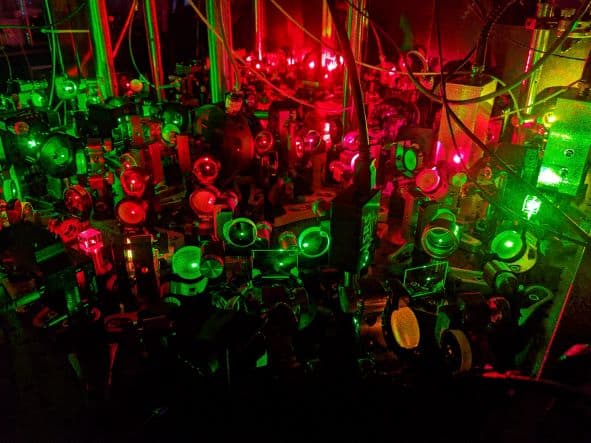Physicists in the US have created ultracold polyatomic molecules by trapping and cooling them directly in three dimensions. Led by John Doyle at Harvard University, the team used a standard device known as a magneto-optical trap (MOT), plus additional laser cooling techniques, to reduce the temperature of a sample of calcium hydroxide (CaOH) molecules to just 110 µK. By showing that direct laser cooling is possible, the result opens the door to experiments in molecule-based quantum simulation and studies of chemical reactions involving polyatomic molecules.
Chemical reactions are complex processes. At temperatures close to 0 K, however, their complexity is greatly reduced, as the atoms and molecules involved can only exist in their lowest-energy quantum ground states. So far, studies of ultracold chemistry have focused on simple interactions between atoms and diatomic molecules or between pairs of diatomic molecules. Introducing polyatomic molecules to this mix would make it possible to study more intricate interactions, but it also introduces additional challenges, as polyatomic molecules are not easily cooled.
Creating ultracold molecules
Ultracold molecules are generally created in one of two ways. The first is to apply laser pulses to a sample of cold atoms and thereby cause them to associate into ultracold molecules. Researchers have used this laser association method on several species of atoms, and recent experiments showed that it can also be used to create triatomic molecules out of diatomic ones. The second approach is to produce the molecules by chemical means in a beam of buffer gas cooled to cryogenic temperatures, then use lasers to cool the molecules further.
Laser cooling has already been successfully applied to diatomic molecules in 3D and triatomic molecules in 1D. Achieving 3D control over triatomic molecules is far more difficult, however, because the molecules must absorb and emit a large number of laser photons before the accumulated momentum “kicks” from each photon slow them down enough that they can be trapped. Each absorption and emission event can also induce rotational or vibrational motion, leaving the molecule in a new quantum state that is no longer resonant with the cooling laser beam. For this reason, additional laser frequencies must be employed to “repump” the molecule back to the correct state – a requirement that rapidly increases the complexity of the experiment.
Some molecules such as SrF and CaOH, however, have electronic transitions that are nearly closed, meaning that their rotational and vibrational modes are excited relatively infrequently. These molecules can therefore be laser cooled by adding only a limited number of repump lasers to close off the remaining transitions.
Cooling stages
In the present study, which is described in Nature, Doyle and colleagues began by producing CaOH molecules in a two-stage buffer gas cell cooled to around 2 K. The CaOH molecules were then slowed to approximately 10 m/s by counter-propagating laser beams before entering the MOT. There, they are simultaneously trapped and cooled as they scatter thousands of photons from six laser beams that are tuned in or out of resonance depending on the molecules’ position in a quadrupole magnetic field. As a final step, the researchers turned off the magnetic field and performed further cooling on the molecules via a so-called “optical molasses” phase. In this phase, the cooled molecules experience forces that slow their movement in 3D, like a person wading through a vat of molasses or other viscous fluid.

Ultracold triatomic molecules herald a new frontier for the three-body problem
Doyle says that the biggest challenge in going from 1D laser cooling to 3D was tuning the source of the slowed beam to optimize the production of the molecules and their velocity. In comparison to previously reported association experiments with triatomic molecules, Doyle adds that his team’s CaOH molecular sample is in its electronic ground state and therefore amenable to single quantum state control (into any rotational or vibrational state). Another advantage, he says, is that CaOH can be detected optically with high fidelity using traditional photon cycling methods, in which thousands of photons are scattered from each molecule and detected on a camera.
A milestone in ultracold chemistry
Bo Zhao, a physicist from the University of Science and Technology of China who was not involved in this research, says that the most important part of the work is that the researchers confined their triatomic molecules in a 3D magneto-optical trap. This, he says, is a milestone because it makes it possible to study ultracold collisions and reactions involving polyatomic molecules rather than just diatomic ones, greatly enriching the field of ultracold chemistry. This is important since studying collisions and reactions involving cold polyatomic molecules is very difficult even for molecular beam experiments.
Doyle says that the team’s next goal is to load an optical tweezer array with CaOH molecules and measure the quantum gate coupling between two of them. “Triatomic molecules have a qualitatively different property, namely the existence of angular momentum-bearing vibrational bending modes,” he tells Physics World. These modes, he adds, are “a tremendous new tool for science” because they should make it possible to perform experiments with polyatomic molecules in quantum simulation and quantum computation.
